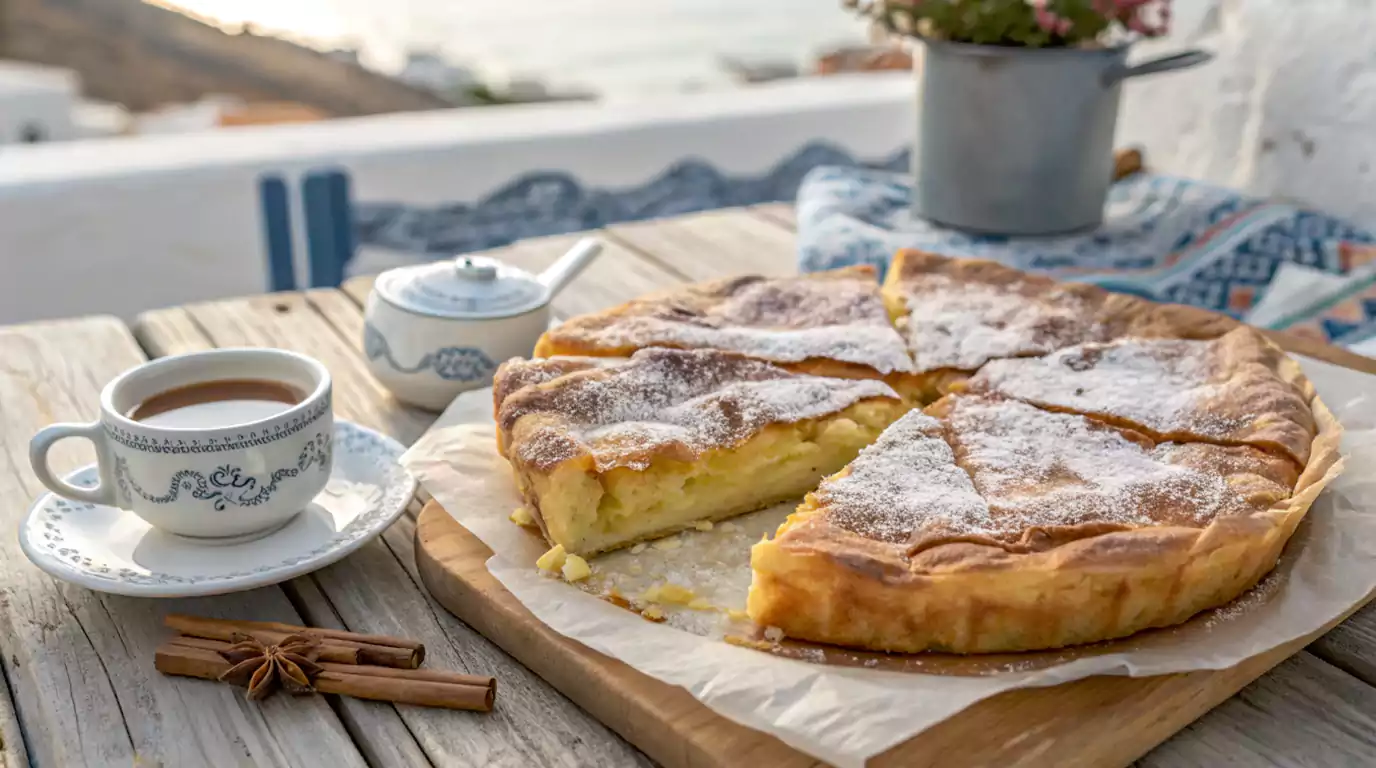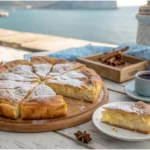Imagine sitting at a sunlit café in Thessaloniki, the air rich with the scent of freshly baked pastries. In front of you, a golden slice of Bougatsa, its crispy phyllo layers crackling under the fork, revealing a warm, creamy custard filling. This traditional Greek delight isn’t just food—it’s an experience, a piece of Greek heritage that has been passed down through generations.
If you’ve ever craved an authentic taste of Greece, you’re in for a treat. In this guide, you’ll discover how to craft the perfect Bougatsa right in your kitchen. From selecting the best ingredients to mastering the delicate balance of crispy phyllo and smooth custard, this recipe will transport you straight to a Greek bakery.
But Bougatsa is more than just a dish; it’s a cultural emblem. Found in bakeries across Greece, especially in Thessaloniki, this pastry has become synonymous with Greek breakfast culture. Whether enjoyed fresh in the morning with a strong cup of Greek coffee or as a sweet evening indulgence, Bougatsa has a special place in Greek culinary history.
Let’s dive into the magic of Bougatsa and learn how to make this iconic dish from scratch.
What is Bougatsa? A Greek Culinary Treasure
Bougatsa is a beloved Greek pastry, often enjoyed as a breakfast treat or dessert. Originating from the northern regions of Greece, particularly Thessaloniki, this delicacy consists of delicate layers of phyllo dough wrapped around a luscious semolina custard filling. Though sweet Bougatsa is the most popular, savory versions filled with cheese or minced meat are equally adored.

The Origins of Bougatsa
Bougatsa has a rich history that traces back to the Byzantine Empire. Over time, it evolved, influenced by both Greek and Ottoman culinary traditions. The name “Bougatsa” is believed to have originated from the Turkish word “pogatsa,” which refers to a filled pastry. Today, Bougatsa remains an essential part of Greek cuisine, particularly in northern Greece.
Why is Bougatsa So Special?
What sets Bougatsa apart is its texture contrast—the flaky, buttery phyllo gives way to a creamy, lightly sweetened custard, dusted with powdered sugar for the perfect finishing touch. The crispiness of the phyllo layers combined with the smooth, rich filling makes it an unforgettable treat.
Whether you’re enjoying it as a morning pick-me-up with Greek coffee or as an indulgent dessert, Bougatsa is a must-try for any lover of Mediterranean flavors.
Ingredients for the Best Bougatsa Recipe
To make an authentic Greek Bougatsa, you’ll need high-quality ingredients. Freshness is key, especially for the custard filling and phyllo dough.
Bougatsa Custard Filling Ingredients
| Ingredient | Quantity | Notes |
|---|---|---|
| Whole milk | 2 cups | Full-fat for creaminess |
| Semolina flour | 1/4 cup | Fine semolina preferred |
| Sugar | 1/2 cup | Adjust to taste |
| Eggs | 2 large | Beaten |
| Vanilla extract | 1 tsp | Pure vanilla for best flavor |
| Butter (melted) | 3 tbsp | Unsalted |
| Powdered sugar | For dusting | Optional but traditional |
Phyllo Dough Layers
| Ingredient | Quantity | Notes |
| Phyllo dough | 8-10 sheets | Thawed if frozen |
| Butter (melted) | 1/2 cup | For brushing between layers |
The secret to the best Bougatsa lies in balancing the richness of the custard with the crispiness of the phyllo layers. Now, let’s move on to assembling this masterpiece.
Step-by-Step Guide – How to Make Bougatsa
Step 1 – Preparing the Custard Filling
- Heat milk and sugar in a saucepan over medium heat until warm, but not boiling.
- Slowly whisk in semolina flour, stirring continuously to prevent lumps.
- Continue stirring until the mixture thickens and has a pudding-like consistency.
- Remove from heat, then mix in beaten eggs, vanilla extract, and butter.
- Let the custard cool slightly before assembling.
Step 2 – Layering the Phyllo Dough
- Preheat your oven to 375°F (190°C).
- Brush a baking dish with melted butter.
- Layer 5-6 sheets of phyllo dough, brushing each with butter to ensure flakiness.
Step 3 – Assembling the Bougatsa
- Pour the custard filling evenly over the phyllo base.
- Cover with another 4-5 sheets of phyllo, buttering each layer.
- Tuck in the edges to encase the filling.
- Bake for 30-35 minutes, or until golden brown and crispy.
Step 4 – Serving Bougatsa the Greek Way
- Allow to cool slightly before cutting.
- Generously dust with powdered sugar and optionally cinnamon.
- Serve warm with Greek coffee or iced frappe.

Serving and Storing Tips
If freezing, wrap tightly in plastic wrap and store for up to one month. Thaw overnight and reheat before serving.
For the best texture and flavor, serve Bougatsa warm, straight from the oven.
If making ahead, reheat in an oven at 300°F (150°C) for 10 minutes to restore crispiness.
Store leftovers in an airtight container in the refrigerator for up to three days.
Avoid microwaving as it softens the phyllo; opt for reheating in an oven instead.
Mistakes to Avoid
Using low-fat milk: Full-fat milk gives the best richness and texture.
Skipping the butter layers: Every sheet of phyllo should be buttered for a crispy texture.
Overcooking the custard: If overcooked, the filling will become too thick and lose its creamy texture.
Using cold phyllo dough: Let it come to room temperature to prevent tearing.
Cutting immediately after baking: Let it rest for a few minutes to prevent the custard from spilling.
Tips for the Perfect Bougatsa
- Use high-quality phyllo dough for maximum crispiness.
- Don’t overcook the custard; it should be creamy, not runny.
- Always butter each phyllo layer to achieve a rich, flaky texture.
- Serve fresh; Bougatsa is best enjoyed warm and crispy.

Variations of Bougatsa – Sweet and Savory
Sweet Bougatsa Variations
- Add cinnamon to the custard for extra warmth.
- Substitute honey drizzle instead of powdered sugar.
Savory Bougatsa Options
- Replace custard with cheese filling (feta or mizithra cheese).
- Add ground beef or spinach for a more filling option.
Frequently Asked Questions
What is Bougatsa made of?
Bougatsa is made with crispy phyllo dough and a creamy semolina custard, dusted with powdered sugar. It can also have savory fillings like cheese or meat.
Can I make Bougatsa ahead of time?
Yes. You can assemble Bougatsa and refrigerate it for up to 24 hours before baking. Bake fresh for best results.
What’s the difference between Bougatsa and Galaktoboureko?
While both are Greek custard pastries, Galaktoboureko is syrup-soaked, whereas Bougatsa is dusted with sugar.
How do I store leftover Bougatsa?
Keep it in an airtight container at room temperature for one day or refrigerate for up to three days. Reheat in the oven for crispiness.
Conclusion
Now that you have the secrets to making authentic Bougatsa, it’s time to bring Greece into your home. Whether you’re baking for a special occasion or simply indulging in a morning treat, this recipe guarantees a taste of Greek tradition.
Try out this Bougatsa and let your creativity shine! We’d love to see your sweet creations. Tag us on Instagram at @SweetEatsRecipes and use the hashtag #Bougatsa to get featured.
Greek Bougatsa
Equipment
- Saucepan
- Whisk
- Baking Dish
- Pastry brush
- Knife
Ingredients
Custard Filling
- 2 cups Whole milk
- 1/4 cup Semolina flour
- 1/2 cup Sugar
- 2 large Eggs
- 1 tsp Vanilla extract
- 3 tbsp Butter (melted)
- Powdered sugar
Phyllo Dough Layers
- 8-10 sheets Phyllo dough
- 1/2 cup Butter (melted)
Instructions
- Prepare the Custard:Heat milk and sugar in a saucepan over medium heat until warm but not boiling.Slowly whisk in semolina flour, stirring continuously to prevent lumps.Continue stirring until the mixture thickens into a pudding-like consistency.Remove from heat and mix in beaten eggs, vanilla extract, and melted butter.Let the custard cool slightly before assembling.
- Layer the Phyllo Dough:Preheat the oven to 375°F (190°C).Brush a baking dish with melted butter.Layer 5-6 sheets of phyllo, brushing each with butter for flakiness.
- Assemble the Bougatsa:Pour the custard filling evenly over the phyllo base.Cover with another 4-5 sheets of phyllo, buttering each layer.Tuck in the edges to encase the filling
- Bake and Serve:Bake for 30-35 minutes, or until golden brown and crispy.Allow to cool slightly before cutting.Dust with powdered sugar and optionally cinnamon.Serve warm with Greek coffee or an iced frappe.
Notes
- Use high-quality phyllo dough for the crispiest texture.
- Bougatsa is best enjoyed fresh but can be stored in the refrigerator for up to three days.
- Reheat in the oven for best results.
- Experiment with variations like cinnamon-infused custard or savory cheese-filled Bougatsa.


